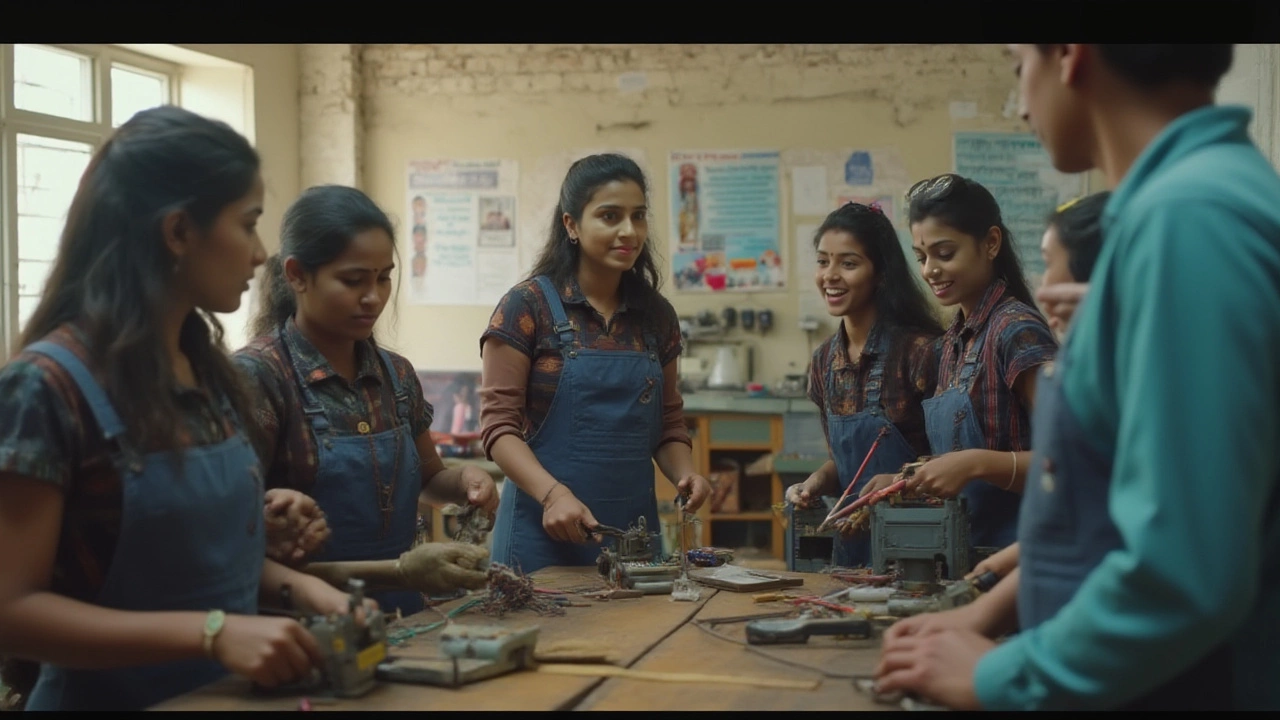If you’ve ever stared at a course catalog or scrolled through college websites, you’ve probably wondered—what’s the real difference between vocational and educational paths? Maybe you’re weighing whether to dive straight into a trade or stick with the classic academic route. You’re not the only one. With nearly 70% of high school grads heading for university (according to UNESCO), and millions choosing skill-based training, there’s real debate swirling around which path gets you further—or happier. The answer isn’t as black and white as some career counselors make it sound. So let’s break it down and look beyond the buzzwords.
Understanding Vocational and Educational Pathways
The word “vocational” sounds old-school, but it simply means training for a specific job or trade. Picture an electrician, a chef, an auto technician—these are folks who learned through hands-on practice, not hours in the lecture hall. Vocational training happens in places like polytechnic schools, community colleges, and even company-run apprenticeship programs. Usually, the learning style is direct—you work with tools, solve real-world problems, and often get paid to learn on the job. No piles of essays or abstract theories, just practical, usable skills you can put to work fast.
Now, “educational,” in the sense most people use it, describes the academic route. Think high school, college, or university—sometimes followed by graduate school. Here, you’re studying subjects like math, history, literature, biology, economics, and more. The goal is broader knowledge, critical thinking, and a theoretical grasp of different topics, rather than a quick jump into a particular career. Instead of immediately training you for, say, aircraft maintenance, an educational path might help you grasp physics or business theory—things you can apply anywhere, but not always in a hands-on way right out of the gate.
Both paths have value, but they don’t work the same way. Vocational training is usually shorter—sometimes just a few months, often a year or two. Academic education usually stretches longer: four years for a bachelor’s degree, sometimes more for advanced study. Tuition costs can vary a lot, too. According to data from the US Department of Education, vocational certificates cost on average $4,000-10,000, while a four-year degree can set you back $40,000 or more. Apprenticeships sometimes let you earn and learn at once, so you graduate debt-free. With academic education, you may pay more up front, betting on bigger earning power later.
So why do people keep confusing them? Blame it on the labels. “Education” sounds official and fancy; “vocational” feels like it’s only for people who can “fix stuff.” But reality throws those old ideas out the window. Plenty of tech and creative jobs—such as graphic design, coding bootcamps, and culinary arts—are built on vocational programs. Meanwhile, jobs like teaching, law, and scientific research still demand academic degrees. Understanding the real differences helps you pick what suits you, not what tradition says you should do.
Real-World Impact: Which Path Gets You What?
It’s tempting to believe that college is the one “correct” answer to success. But check out how things actually shake out. According to a 2024 National Skills Coalition report, nearly 53% of US jobs are classified as “middle-skill”—meaning they typically require something more than a high school diploma but less than a four-year degree. Think healthcare technicians, construction managers, IT support specialists, and welders. These jobs often pay well (sometimes $50,000 or more starting out) and have huge demand nationwide. Yet only about 43% of the workforce is trained for these spots. That’s a big mismatch—and a massive opportunity for anyone with vocational skills.
But what about the long term? While college grads pull ahead on average annual salaries over time—a 2023 Georgetown University study shows bachelor’s degree holders average $2.8 million in lifetime earnings compared to $1.6 million for vocational certificate holders—that gap closes or even reverses in high-demand trades. For example, master electricians, dental hygienists, or elevator technicians with certifications often outearn entry-level office workers with college degrees, especially since they skip years of tuition bills and can start earning earlier.
But jobs, not just money, matter to a lot of people. The hands-on nature of vocational paths appeals to those who want their work to feel tangible and direct. You can literally see the house you built or the customer’s smile after you fix a car. On the flip side, academic education tends to open broader doors—research, management, government, education itself, or creative sectors where a broad knowledge toolkit is handy. If you dream about inventing new technology or teaching, that wider lens might matter.
| Pathway | Typical Duration | Median Starting Salary | Cost Range | Common Careers |
|---|---|---|---|---|
| Vocational | 6-24 months | $40,000-55,000 | $4,000-$12,000 | Electrician, Plumber, Chef, Dental Hygienist |
| Academic | 3-6 years | $35,000-65,000 | $18,000-$60,000+ | Teacher, Engineer, Manager, Scientist |
That chart sums up some common choices. But remember, these aren’t hard lines in the sand. People jump between paths all the time—some start in a trade, then go to college later, or vice versa. Hybrid programs, like work-study degrees or “earn and learn” partnerships, blur these lines more. There’s even a growing push in Europe (Germany’s dual system is famous) and Japan for mixing training with classroom study, giving students both the depth of education and the practicality of vocational work. The choice is less about prestige, and more about what actually fits.

How To Decide: Tips For Picking the Right Track
Choosing between the two isn’t just about following friends—or what your parents did. The right path often starts with an honest look at your own interests and strengths. Love working with your hands, solving real-world problems, or getting into a job ASAP? Vocational training lets you skip the lecture marathons and move straight to the action. Enjoy ideas, theory, and a broader approach? The educational track lets you explore different subjects before settling on a career.
But there’s more. Here are some useful tips if you’re on the fence:
- Try job shadowing or internships before you commit either way. A week in a hospital or engineering office can teach you tons more than any website.
- Don’t ignore growth areas. Healthcare support, IT, skilled trades, and digital services are all desperate for new talent—many with vocational programs.
- Look at job security and automation risk. Many hands-on jobs—HVAC techs, home health aides—are hard to automate, while some traditional office jobs could shrink in the next decade, according to Bureau of Labor Statistics forecasts for 2025-2035.
- Check payback and debt. If you don’t want years of loans, vocational programs often let you skip big bills—sometimes employers cover your training, especially with apprenticeships.
- Mix it up! Many people build a combo—start with a certificate, then return for a degree, or vice versa. There’s no rule that you can’t change your mind.
Parents and counselors sometimes push one option based on status alone, but talk to people actually working in those fields for the straight story. The best fit is always the one that matches your brain, your heart, and your budget—not just your high school GPA.
Future Trends: Are Vocational and Educational Lines Blurring?
Tired of hearing you need a college degree to “succeed”? You’re not alone. In 2025, some of the world’s biggest companies—including Google, IBM, and Tesla—hire for certain roles based on skills, not diplomas. Coding bootcamps and portfolio-based hiring are making their way into industries from software to design—even some banks now train new hires on the job, skipping traditional degrees.
Meanwhile, schools are catching up. Expect more hybrid models, where traditional universities offer short-term certificates and practical work placements alongside degree courses. Data from India’s Ministry of Education in 2024 shows a 36% jump in “skill-based” enrollment, as students look for flexible, faster ways into the job market. Some colleges now partner with local manufacturers, hospitals, or tech firms to create new hybrids—so you get both classroom knowledge and hands-on practice.
If you’re thinking internationally, vocational training has huge respect in countries like Germany, Switzerland, and Australia. These nations boast youth unemployment rates under 7%—compared to 12-17% in places that push only academic routes. By 2030, global experts predict that half the world’s working population will need re-skilling or upskilling—so even if you start on one path, you’ll probably need to learn new skills as you go.
This isn’t just about entry-level jobs or getting started. Lifelong learning is becoming the new normal. Even white-collar jobs now want training in coding, digital literacy, or management on top of older credentials. People proudly stack certificates, micro-credentials, and degrees on LinkedIn profiles. So, when you’re comparing vocational and *educational* paths, ask yourself: What fits your life now—and what’s still going to work for you a decade from now?
There’s no shortcut, but there are a dozen ways in. The smartest move? Stay curious, stay flexible, and focus on adding real skills, not just collecting papers. Your future self will probably thank you for picking the difference that matters to you, not just the one with the best label.


